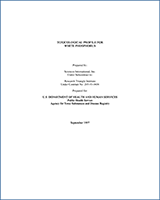NCBI Bookshelf. A service of the National Library of Medicine, National Institutes of Health.
Toxicological Profile for White Phosphorus. Atlanta (GA): Agency for Toxic Substances and Disease Registry (US); 1997 Sep.

Toxicological Profile for White Phosphorus.
Show details4.1. PRODUCTION
The domestic production capacity of elemental phosphorus in 1992 was 294,000 tons (SRI 1992). The demand for elemental phosphorus is expected to decrease (1-2%) during this decade (CMR 1991). The three companies that presently manufacture elemental phosphorus in the United States for sale or distribution are FMC Corp., Pocatello, Idaho; Monsanto Co., Soda Springs, Idaho; and Rhone-Poulenc Inc., Silver Bow, Montana (SRI 1995). The U.S. facilities that manufactured and processed white phosphorus in 1993 are given in Table 4-1 (TR193 1995). White phosphorus is produced by several methods. One of the most important commercial production processes involves grinding phosphate rock, forming it into pellets, and heating them with coke or silica in an electric furnace. The elemental phosphorus vapor produced is then cleaned and collected by passing the vapor through an electrostatic precipitator and condenser (EPA 1989).
WP/F is manufactured in the Pine Bluff Arsenal in Pine Bluff, Arkansas. Molten white phosphorus stored under water is loaded in munitions shells either by the dip-fill or dry-fill methods (Berkowitz et al. 1981). In the dip-fill method, the shell canisters containing the felt wedges are passed through tubs of molten phosphorus under water. In the dry fill method, molten phosphorus is added directly to the canister under an inert atmosphere. The latter method greatly reduces phosphorus waste (phossy water) and environmental contamination (Spanggord et al. 1983).
4.2. IMPORT/EXPORT
In 1991, an estimated 5% of the production of elemental phosphorus was exported (CMR 1991). In 1982, the amount of imported elemental phosphorus from other countries to the United States was negligible (C&EN 1982) and probably remains so because the production capacity in the United States remains higher than the demand (CMR 1991).
Table 4-1
Facilities That Manufacture or Process White Phosphorus.
4.3. USE
In 1991, ≈83% of elemental phosphorus available in the nonmilitary market was used in the production of phosphoric acid and phosphates, 12% was used in the production of direct reaction chemicals, such as phosphorus trichloride, pentasulfide, and pentoxide and red phosphorus, and 5% was exported (CMR 1991; EPA 1989). Phosphates are generally used in the fertilizer industry, food and beverage industry, industrial and institution cleaning compounds, water and waste treatment, animal diets and in metal treatment (CMR 1991; van Wazer 1982). Small amounts of white phosphorus are used in roach and rodent poisons (van Wazer 1982). In military use, white phosphorus is used as an ammunition for mortar and artillery shells and hand and rifle grenades (EPA 1989). In the past, white phosphorus was used in the manufacture of matches. However, due to health considerations (jaw-bone necrosis), red phosphorus and tetraphosphorus trisulfide (P4S3) have replaced white phosphorus since the Beme Convention of 1906 (Nyunt 1983). More recently, the use of white phosphorus has been suggested for removing nitric oxide from flue gas generated during the combustion of fossil fuels in power plants (Chang and Lee 1992; Chang and Liu 1990; Liu et al. 1991).
4.4. DISPOSAL
According to the United Nation’s treatment and disposal methods for wastes containing phosphorus, the two recommended methods of disposal are incineration and open burning (HSDB 1993). In the open burning method, the waste should be mixed with wet earth, allowed to dry, and ignited in a remote place. The ultimate method of disposal is controlled incineration and treatment of emitted gases by alkaline scrubbing and particle removal equipment (HSDB 1993). Landfilling phosphorus-containing wastes is not recommended by the United Nation’s treatment and disposal methods (HSDB 1993). However, most of the wastes produced by U.S. manufacturers or processors of white phosphorus are disposed of in landfills (see Section 52.3). In the current disposal practice, retired or outdated army munitions are reprocessed to recover phosphorus. The munitions shells, which are still contaminated with white phosphorus, are incinerated in fluidized bed incinerators equipped with after burners and scrubbers (Berkowitz et al. 1981; Uhrmacher et al. 1985). Waste water containing phosphorus (phossy water) can be treated with ozone in a sparged stirred reactor (Campbell 1977). The resulting phosphate ions may be removed as a calcium phosphate precipitate by adding lime. Campbell (1977) claimed this process reduced the phosphorus levels in phossy water below the limit of detection (<22 µg/L).
Elemental phosphorus is listed as a hazardous substance and the discharge in excess of 1 pound to surface water is in violation of section 311(b)(3) of the U.S. code of regulations (EPA 1992a). Solid waste containing elemental phosphorus is characterized as a hazardous waste when it passes the characteristic of reactivity stipulated in 40 CFR 261.23. If so characterized, the solid waste must be managed as a hazardous waste (EPA 1992b).
- PRODUCTION, IMPORT, USE, AND DISPOSAL - Toxicological Profile for White Phosphor...PRODUCTION, IMPORT, USE, AND DISPOSAL - Toxicological Profile for White Phosphorus
Your browsing activity is empty.
Activity recording is turned off.
See more...